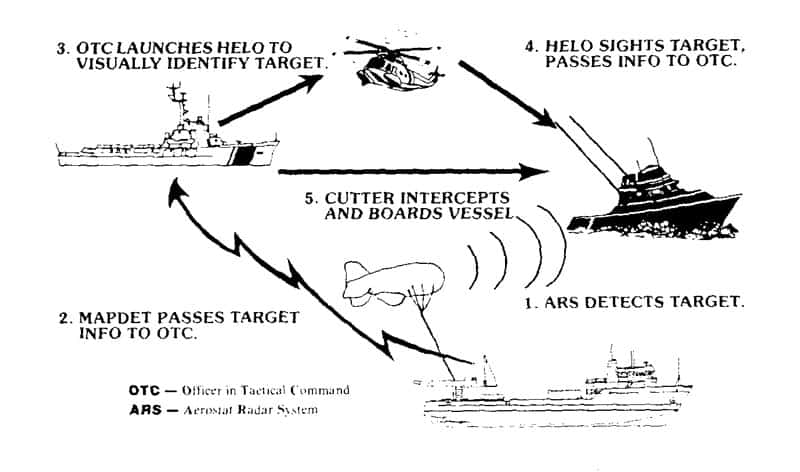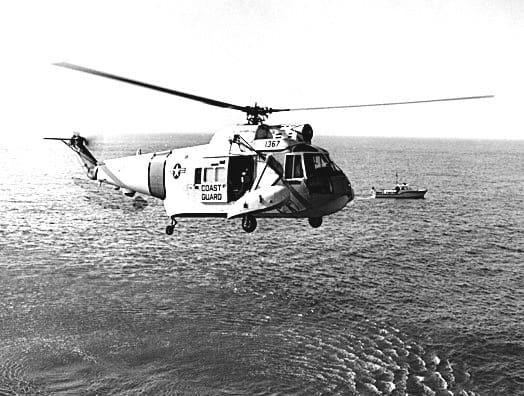HH-52A
Operation HAT TRICK was a series of offensive operations. The first offensive strike was a DEA special operation which located the cocaine-processing facilities in Colombia. Mexico had gotten back in marijuana production and Mexican Federal Police and DEA agents destroyed a large marijuana growing operation in Chihuahua. The Chihuahua operation was the second strike. The third offensive operation was maritime; known as Operation Wagon Wheel, it was a multinational, multi-service, winter drug interdiction operation, which included protracted operations in the Caribbean, off the coast of Colombia, and in the Bahamas. RADM Richard Cueroni, Commander of CGD7 and NBISS Coordinator, had the operational responsibility. The plan was conceived and executed by CAPT G.Stephen Duca as Chief of Operations.
The operation was planned in two phases. Phase I was the deployment of ships and aircraft to reinforce the patrol line in the western Bahamas and along the choke points from the Yucatan Peninsula to the Virgin Islands. In Phase II the patrol force moved south to the coastal waters of Central and South America with a focus on the Guajira Peninsula of Colombia. The operation covered a segment of a circle with an arc extending from the Yucatan Peninsula to the eastern boundary of the Leeward Islands, touching Panama and Colombia. The area inside the segment, with its center in South Florida, encompassed the Caribbean. The operating area was divided into three zones. The departure zone was near drug-producing nations and trans-shipment points extending seaward from their territorial limits to 100 nautical miles. The arrival zone was the mainland of the United States and its territorial waters to a point 12 nautical miles offshore. The area in between was the transit zone.
Operation WAGON WHEEL forces consisted of the Coast Guard cutters Northwind (WAGB-282) serving as flag ship, four high endurance cutters, six medium endurance cutters, two surface-effect cutters, two patrol boats and four buoy tenders. The Navy contributed a guided-missile destroyer (DDG), a guided missile frigate (FFG) and three high-speed hydrofoils (PHM). Air support was three Navy P-3 Orions, two Coast Guard C-130s, and a Coast Guard HU-25 Falcon, for long range surveillance. Five Coast Guard HH-52 helicopters operated from surface ships.
Phase I began 31 October 1984. Phase II began 22 November as the patrol line moved south toward Colombia.
From a maritime interdiction viewpoint confiscation and seizures were less than spectacular and was so noted in the Press. Continuous rain in the marijuana growing areas washed out roads and trails leading to the storage areas. Gale force winds kept many grass boats in the harbor. There is, however, more to the story. Planning for the operation was a closely held secret but this did not last long. The news media broadcasted the event six days before the Caribbean Squadron started its move southward. Alerted, the smugglers began to stockpile marijuana ashore to wait out the United States Forces. The political climate in Colombia was changing and as a result Colombian Forces made in country sweeps eliminating the stock piles. This was not reported by the media. The Caribbean-Squadron joint operation itself was very successful and was kept in place.
Planning started immediately for Hat Trick II, a continuation of the original sea-air effort. The second operation was larger and more diversified. All military services supported the Coast Guard, Customs and DEA. The governments of Colombia, Panama, Venezuela and Jamaica cooperated. The Coast Guard and Navy were the primary maritime interdiction forces while Customs and all military services did air interdiction. A three month concerted effort resulted in the seizure of 1.7 million pounds of marijuana, 22,000 pounds of cocaine and the arrest of 1,300 drug traffickers.
By 1986 Hat Trick became more of a concept than a special operation. It became a year around effort focusing on strategy as well as tactical operations. The Caribbean-Squadron (CARIBRON) concentrated on the departure zones adjacent to the drug producing countries. Both Coast Guard and Navy vessels took part in the operations. Coast Guard law enforcement details (LEDET) were assigned to all Navy ships. Navy ships were under the tactical command of the Coast Guard. Long-range air support was provided by Coast Guard C-130s and Navy P-3s. Local air surveillance was the responsibility of embarked Navy and Coast Guard helicopters. Pulse operations were initiated and, depending on the mission, additional air support was also given by Customs aircraft, Air Force E-3 AWACS, Navy E-2C Hawkeyes, Coast Guard HU-25 Falcons, Marine Corps OV-10s, and Royal Dutch Air Force F-27 aircraft.
The choke-points were reinforced and Coast Guard manned sea-based aerostat vessels were placed on station to increase radar detection capabilities. State of the art electronics were carried aloft to heights up to 2500 feet by helium balloons (SBAs) tethered to a ship referred to as a mobile aerostat platform (MAP). This provided a great increase in radar detection capability. The MAP worked with one or more cutters with embarked helicopters. These were called maritime interdiction surveillance teams (MISTs). A target information system aboard the MAP sent a protected video display directly to the cutter which served as the MIST command and control vessel. The helicopter then investigated the SBA targets. The MAPs were capable of refueling the cutters at sea. The main drawback to the system was that the aerostats were susceptible to weather. A strong wind or a lightning strike could put the aerostat out of commission. Weather therefore had to be monitored at all times. In spite of this shortcoming the aerostats proved to be effective.

The effectiveness of aerial surveillance coupled with ship-board operation proved itself time and again. Naval Air Reserve P-3s and Coast Guard C-130s flew patrols over choke points and primary drop zones. Some of the C-130s were equipped with SLIR which provided an excellent surveillance path covering an area of 35 miles each side of track line from an altitude of 8,000 feet. Upgrading C-130 capabilities continued. This, coupled with increased profile abilities on the part of the aircrews, resulted in a flow of information to the surface vessels which produced positive results. HH-52 helicopters carried on board Coast Guard cutters served as “eyes over the horizon.” Examples of the effectiveness of this concept are numerous. Typical is a multiple drug bust made by the Coast Guard cutter Diligence (WMEC-616). A long range surveillance aircraft located a vessel east of the Bahamas that matched the profile and was apparently disabled. The information was relayed to the Diligence. When the cutter arrived on scene investigation revealed that the vessel was the Bismarck, she was indeed disabled, she was stateless, and her cargo was 30 tons of marijuana. The Diligence took the Bismarck in tow and headed west to Florida. The cutter continued to deploy her helicopter en route to Miami. During a surveillance flight the helo crew sighted the motor vessel Rosangle with 40 marijuana bales exposed on deck. Since the Diligence was engaged with a tow the cutter Lipan was dispatched, made the seizure, and took six prisoners.
By 1986 marijuana was transported in hidden compartments, mother ships were having trouble getting through the Caribbean and were going further to the east in the open ocean. Intelligence was better, the drug operations were being penetrated, marijuana smuggling operations were converting to cocaine, production was down in Colombia and up in Mexico and domestically. Seizures were down but the price of marijuana was going up. The signs were there. RADM Howard B. Thorsen, USCG Southeast Region Coordinator and Seventh District Commander estimated an interdiction rate of 50% and up to 60% in some cases. The Admiral’s estimates would prove to be conservative. Ambrose Weldon, kingpin of the Gulf off-load organization, stated losses exceeded 80% in 1987. Colombian suppliers arranged off-loads at the Belize-Mexico border. He further stated that he had to negotiate with Cuban intermediaries to arrange off-loads within 200 miles of his high-speed boats. Attrition had cut deeply into reliable help. By the end of the year 1987 there were no assets left. (Ambrose Weldon was a cover name given to protect the principal). Colombian multi-ton marijuana smuggling ended in 1987. Total marijuana seizures dropped to about 400,000 in 1988. The media had defined the maritime interdiction program as unwinnable. The Coast Guard had conducted a successful war of attrition in spite of inter-agency disagreements and a lack of clear direction from the administrations. This was not mentioned by the Press. By 1990 an astonishing 74% of marijuana taken was seized on land at or near the Mexican border. By 1993 the wholesale price of marijuana had risen to $1500 a pound.
Cocaine was a different story. Maritime seizures had risen significantly and would continue to do so but about half of the volume transported by sea was done using commercial maritime containers. Large merchant ships transporting multiple containers were almost impossible to search at sea. Most of the cocaine smuggling was done by air. Air interdiction leading to apprehension at a delivery point was the method of operation. Cocaine had become a real problem by 1985 and in 1986 the Anti Drug Act established a role for the Coast Guard in air interdiction.
Note: Cocaine interdiction efforts are also addressed under the Air Interdiction heading and the OPBAT heading

